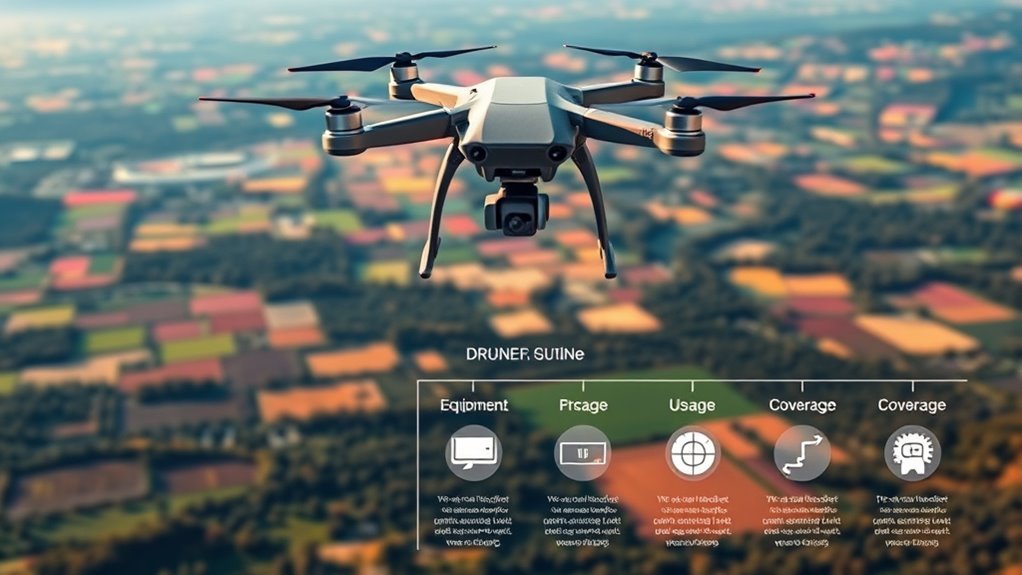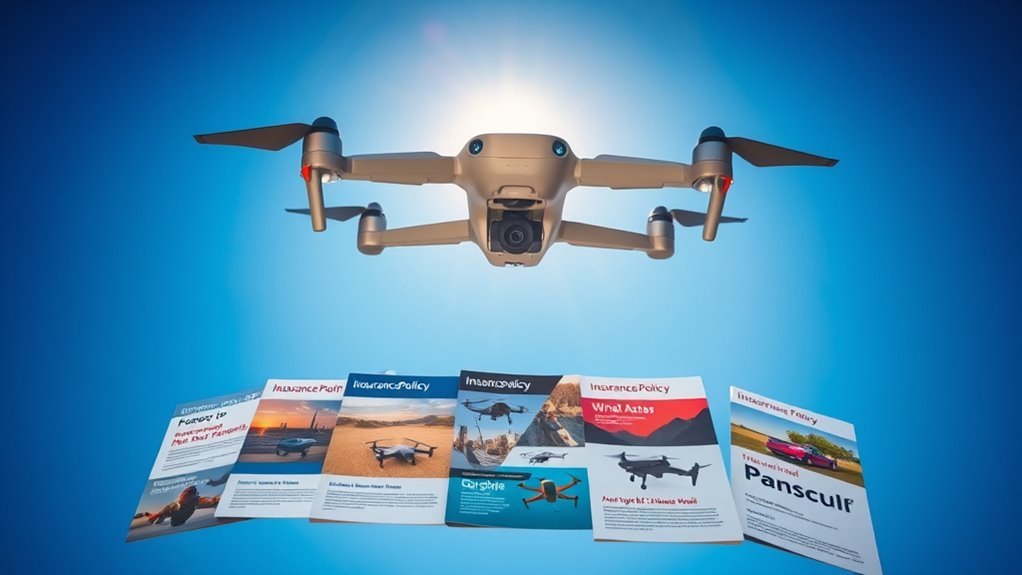Drone insurance costs vary greatly. For basic liability coverage, you’re looking at about $10 to $25 per month. If you need extensive policies for commercial use, expect to pay between $50 and $100 monthly. Several factors influence these prices, such as your drone’s type, your flying experience, and coverage limits. It is crucial to understand these variables to make an informed decision. Continue on to explore more aspects of drone insurance pricing and coverage options.
Understanding Drone Insurance

When you consider the complexities of operating a drone, it’s vital to understand the nuances of drone insurance. This coverage isn’t just a formality; it’s a necessity shaped by various drone regulations that dictate liability and risk management. Different insurance providers offer tailored policies, which can greatly influence your operational freedom. Understanding these regulations can help you assess the potential risks associated with your drone activities, ensuring that you’re adequately protected. Additionally, grasping the distinctions between different insurance options allows you to make informed choices that align with your specific needs. Ultimately, a thorough understanding of drone insurance is fundamental in maneuvering both the legal landscape and the potential financial repercussions of accidents or damages.
Types of Drone Insurance Coverage

When considering drone insurance, it’s important to understand the various types of coverage available. Liability insurance protects you against claims for damages or injuries caused by your drone, while hull coverage addresses physical damage to the drone itself. Additionally, non-owned aircraft protection can safeguard you if you operate a drone that you don’t own, making it vital to evaluate your specific needs.
Liability Insurance Explained
Liability insurance serves as an essential safeguard for drone operators, protecting them against financial repercussions stemming from accidents or damages caused by their aerial activities. Understanding the types of liability coverage is vital for effective risk management. Here are four key aspects to take into account:
- Bodily Injury Coverage: Covers medical expenses for injuries caused to third parties.
- Property Damage Coverage: Protects against damage to someone else’s property due to drone operations.
- Personal Injury Coverage: Addresses claims related to defamation or privacy violations.
- Aggregate Limits: Refers to the maximum amount the insurer will pay during a policy period.
Hull Coverage Details
Hull coverage is one of the fundamental components of drone insurance, providing protection for the physical aircraft itself. This type of hull insurance covers damage resulting from accidents, crashes, or other unforeseen events that can impair your drone’s functionality. When considering hull insurance, it’s essential to understand the coverage limits, as these can vary considerably depending on your policy. You’ll want to guarantee that the coverage adequately reflects the value of your drone and any specialized equipment it may carry. Additionally, be aware that some policies might include exclusions, such as wear and tear or pilot error. By thoroughly reviewing the terms, you can tailor your hull coverage to fit your operational needs and safeguard your investment effectively.
Non-Owned Aircraft Protection
While you may primarily operate your own drone, it’s vital to contemplate the potential risks associated with using non-owned aircraft. Non-owned liability coverage protects you during drone operations involving rented or borrowed drones. Here are four key benefits of this coverage:
- Financial Security: It shields you from costly claims against damage or injury.
- Broader Protection: Covers various scenarios where you’re liable while using another’s drone.
- Flexibility: Allows you to engage in diverse projects without worrying about aircraft ownership.
- Compliance: Guarantees you’re meeting legal requirements for liability in commercial drone operations.
Investing in non-owned aircraft protection is fundamental for any serious drone operator seeking freedom and security in their aerial endeavors.
Factors Influencing Drone Insurance Costs

When considering drone insurance costs, several key factors come into play. The type and model of your drone can substantially influence premiums, along with the amount of coverage you select. Additionally, your experience level as a pilot is a critical aspect that insurers assess when determining your rates.
Drone Type and Model
Drone type and model play an essential role in determining insurance costs, as various designs and specifications can greatly influence risk assessments. When considering drone insurance, you’ll want to look at specific factors that impact pricing:
- Drone Specifications: Advanced features may elevate risk, affecting premiums.
- Weight and Size: Heavier drones often incur higher liability due to potential damage.
- Model Comparisons: More popular models may have more available data, influencing costs.
- Usage Intent: Commercial drones usually carry higher risks than recreational models.
Coverage Amount Selected
The amount of coverage you select directly impacts your insurance costs, as higher coverage limits typically lead to increased premiums. When considering your policy selection, it’s essential to evaluate the potential risks associated with your drone operations. If you’re flying in crowded areas or capturing high-value footage, opting for higher coverage limits may provide peace of mind. Conversely, if your drone use is limited to recreational purposes or lower-risk environments, you might choose a more modest coverage limit to keep costs down. Ultimately, finding the right balance between adequate coverage and affordability is key, ensuring you protect your investment without overextending your budget. Evaluating your specific needs will guide you in making an informed decision regarding coverage limits.
Pilot Experience Level
Although many factors influence drone insurance costs, pilot experience level plays a crucial role in determining premiums. Insurers assess your training and experience to gauge risks. Here are four key aspects they consider:
- Pilot Training: Formal training can lower premiums, showcasing your commitment to safe flying.
- Experience Levels: More flying hours typically translate to lower risk, resulting in reduced costs.
- Accident History: A clean record can markedly decrease your insurance rates.
- Type of Operations: Commercial operations often require more experience; insurers may adjust premiums accordingly.
Average Cost of Drone Insurance
When considering the average cost of drone insurance, you’ll find that prices can vary considerably based on several factors. The type of coverage, your drone’s value, and your flying experience all play a significant role. Here’s a simple breakdown of typical costs:
| Coverage Type | Monthly Cost | Annual Cost |
|---|---|---|
| Liability Only | $10 – $25 | $120 – $300 |
| Full Coverage | $25 – $50 | $300 – $600 |
| Commercial Use | $50 – $100 | $600 – $1,200 |
Understanding drone insurance benefits helps dispel common misconceptions about its necessity. While expenses may seem overwhelming, the protection it offers can be invaluable, ensuring your freedom to fly without worry.
How to Get Drone Insurance Quotes
How can you efficiently gather drone insurance quotes that meet your specific needs? Start by following these steps to guarantee you’re making an informed choice among various drone insurance providers:
- Research providers: Identify reputable drone insurance providers with positive reviews and extensive coverage options.
- Use online tools: Utilize online platforms that specialize in quote comparison to streamline your search.
- Specify your needs: Clearly outline your insurance requirements, including coverage limits and any specific risks associated with your drone usage.
- Request multiple quotes: Contact several providers to obtain quotes, allowing you to compare costs and coverage effectively.
Tips for Reducing Drone Insurance Premiums
While many drone operators may feel overwhelmed by insurance costs, there are effective strategies to help reduce premiums without sacrificing essential coverage. Prioritizing drone safety is vital; maintaining a clean flying record can lead to premium discounts. Consider enrolling in a recognized training program, as completing safety courses often demonstrates responsibility and can lower costs. Additionally, choosing a higher deductible can result in reduced monthly premiums, but make sure you’re comfortable with the potential out-of-pocket costs. Finally, regularly comparing quotes from different insurers could reveal better deals tailored to your needs. By implementing these strategies, you can achieve the freedom to operate your drone confidently while managing your insurance expenses effectively.
The Importance of Regularly Reviewing Your Coverage
Regularly reviewing your drone insurance coverage is crucial for making certain that you’re adequately protected as your needs evolve. Life changes, and so do risks, making it essential to conduct periodic assessments. Here are key reasons to prioritize coverage updates and policy adjustments:
- New Equipment: If you acquire additional drones or accessories, update your policy to cover these assets.
- Changing Regulations: Confirm you’re compliant with any new laws or industry standards affecting your operations.
- Business Growth: As your business expands, your insurance needs might increase; adjust your coverage accordingly.
- Claims History: Review your claims to identify patterns that may necessitate policy changes or improved coverage options.
Staying proactive helps you maintain the freedom and security you desire in your drone operations.
Frequently Asked Questions
Can I Get Drone Insurance for Recreational Use?
Yes, you can get drone insurance for recreational use. Look for policies that offer recreational coverage, ensuring you’re protected while flying. There are various policy options available to suit your specific needs and preferences.
Does Drone Insurance Cover Theft or Loss?
Drone insurance can include theft coverage and loss protection, but specifics vary by policy. You should carefully review your options to guarantee your investment is safeguarded against potential theft or damage for peace of mind.
How Do I File a Drone Insurance Claim?
To file a drone insurance claim after an accident, you’ll need to document the incident thoroughly, notify your insurer promptly, and follow their specific insurance process, ensuring all required information is provided for a smooth resolution.
Are There Exclusions in Drone Insurance Policies?
When traversing the skies of drone insurance, you’ll find policy limitations and coverage exclusions can act like storm clouds. It’s essential to read the fine print, as they can impact your financial safety during claims.
What Happens if I Fly My Drone Without Insurance?
Flying your drone without insurance exposes you to legal consequences and significant financial liability. If an accident occurs, you could face costly lawsuits and repairs, limiting your freedom to operate your drone without worry.

